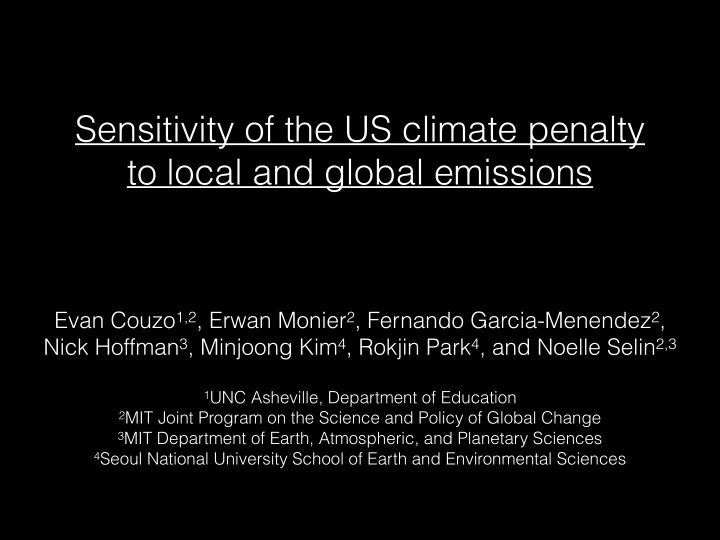

Sensitivity of the US climate penalty to local and global emissions Evan Couzo 1,2 , Erwan Monier 2 , Fernando Garcia-Menendez 2 , Nick Hoffman 3 , Minjoong Kim 4 , Rokjin Park 4 , and Noelle Selin 2,3 1 UNC Asheville, Department of Education 2 MIT Joint Program on the Science and Policy of Global Change 3 MIT Department of Earth, Atmospheric, and Planetary Sciences 4 Seoul National University School of Earth and Environmental Sciences
Climate influence on air quality is complex! Projected changes in 2100 relative to present Climate change impacts air quality Air surface temperature through a number of mechanisms: • chemistry • ventilation and stagnation • biogenic emissions • deposition rates Precipitation Climate Penalty = degradation of air quality under climate change in the absence of emissions changes Monier et al. (2014) The climate penalty is likely a function of both climate and non-GHG emissions. To what extent do non-GHG anthropogenic emissions affect the climate penalty?
Is climate penalty a function of anthropogenic emissions? Present Future Climate Climate Present Emissions Climate Penalty Future Emissions Combined Anthropogenic Emissions Effect
Modeling climate impacts on AQ requires linked models. Socioeconomic Global/regional chemical General Circulation Models emissions scenarios transport models Large uncertainties are associated with climate simulations and • propagate to projections of air quality. Characterizing uncertainty across the complete human-climate • system is essential to generation policy-relevant insights and guide environmental decision-making.
MIT’s Integrated Global System Model is self-consistent. Global Economic Model Earth System Model (EPPA) MIT’s 3 scenarios: - Multiple climate sensitivities GHG IGSM REF (unconstrained emissions) - emissions - Linked to Community Atmosphere Model POL4.5 (GHG mitigation) - (CAM) to provide meteorological fields POL3.7 (more stringent mitigation) - O 3 -PM precursor CAM emissions meteorology/climate Chemical Transport Model (GEOS-Chem) Focus on O 3 and PM 2.5 GEOS-Chem v9.02 with full chemistry • 2 x 2.5 degrees, 47 vertical layers • 10-year simulations to capture climate variability • 1995-2004 and 2095-2105 • MIT’s IGSM used to drive CAM • GEOS meteorological fields replaced with CAM meteorology • Base emissions from 2006 projected for a future high emissions • “no climate policy” scenario (REF)
REF induces similar temperature increase to RCP 8.5. REF is high emissions no-climate policy scenario.
REF US anthropogenic emissions changes from 2006. • NO, NMVOC, and CO emissions increase in REF scenario • SO 2 emissions decrease sharply
REF anthropogenic emissions changes from 2006.
Annual average O 3 climate penalty leads to increases. • O 3 Climate penalty is climate penalty (2006 emissions) greater when using 2006 emissions. • Two hot spots: northeast and southwest. • Climate penalty up to 9.2 ppb with 2006 emissions. climate penalty (REF emissions) • Garcia-Menendez (2015) showed more regional variation (e.g. north and northwest decreased), but they used annual 8-hr max. climate penalty (2006 emissions) Garcia-Menendez et al. (2015)
Why is climate penalty smaller with greater emissions? • Same Δ climate produced more O 3 with 2006 emissions than REF climate penalty (2006 emissions) emissions • Anthropogenic NMVOC increase likely small compared to biogenic NMVOC increase • Greater NOx efficiency ( δ O 3 / δ NOx) with lower NOx emissions, not converting as much NOx to O 3 in climate penalty (REF emissions) REF • More NOx becoming HNO 3 (surrogate for NOz) as a result of climate with REF emissions. HNO 3 : CP(REF) - CP(2006)
Sign of PM 2.5 climate penalty dependent on emissions. • US-wide increases in climate climate penalty (2006 emissions) penalty under 2006 emissions (except for upper midwest). • Under 2100 emissions, the climate penalty becomes negative (climate benefit) except for northwest. • Maximum climate penalty increase is 1.3 ug/m 3 using 2006 emissions. Maximum decrease is 1.2 ug/m 3 climate penalty (REF emissions) using 2100 emissions. • Sign and magnitude of PM 2.5 climate penalty agrees with Garcia- Melendez (2015) using 2006 emissions. climate penalty (2006 emissions) Garcia-Menendez et al. (2015) PM 2.5 calculations do not include windblown dust.
Climate and emissions affect PM 2.5 species differently. 2000 2100 climate penalty climate climate 2006 emis. REF emis. anthro emissions
Climate and emissions affect PM 2.5 species differently. ↑ T = ↑ SO 2 oxidation 2000 2100 ↑ T = ↑ gas-phase HNO 3 climate penalty climate climate 2006 emis. ↑ NOx emissions REF ↓ SO 2 emissions emis. anthro emissions
Conclusions O 3 PM 2.5 e2006 e2006 eREF eREF eREF e2006 e2006 eREF eREF m2000 m2100 m2000 m2000 m2100 m2000 m2100 m2000 m2100 • Climate penalty is reduced under REF emissions scenarios. • Spatially averaged O 3 penalty is 2.2 ppb (e2100) and 5.3 ppb (e2006). PM 2.5 penalty is -0.3 ug/m 3 (e2100) and 0.3 ug/ m 3 (e2006). • Climate decreases nitrate and increases sulfate. • Choice of emissions year determines whether climate causes PM 2.5 increase or decrease .
Next steps • Calculate population-weighted averages (should increase the climate penalty) • Use longer climate averaging period (20 years or 30 years as in Garcia-Menendez et al. (2015)) • Look at chemical indicators (e.g. δ O 3 / δ NO 2 , δ O 3 / δ HNO 3 ) • Simulate climate policy/lower emissions scenarios • Include climate effects on wildfires and dust • Perform complete benchmarking/model performance evaluation
Thanks.
Recommend
More recommend